For bird watchers, hummingbirds are an exciting sight. These tiny birds are simply stunning, with their sleek, agile forms, and their exotic rainbow of color. Most hummingbirds are native to Mexico, South America, Texas, and even the Bahamas, but there are still a few that are native to Florida. To see these, you’ll need some of their favorite red, nectar-filled flowers in your garden, a hummingbird feeder, and a dash of luck!
Various hummingbirds may briefly visit, both year-round and especially in the winter. These nectar-loving birds return for the sunlight and rain that creates the lush, flowery landscape Florida is known for. Here are 14 hummingbirds that you might see in Florida, from common to rarer:
Common Hummingbirds in Florida (Native)
These are the hummingbirds that are native to Florida, breeding and spending their time there for almost the entire year. You’re most likely to see one of these hummingbirds at your garden or feeder!
Ruby-throated Hummingbird (Archilochus colubris)
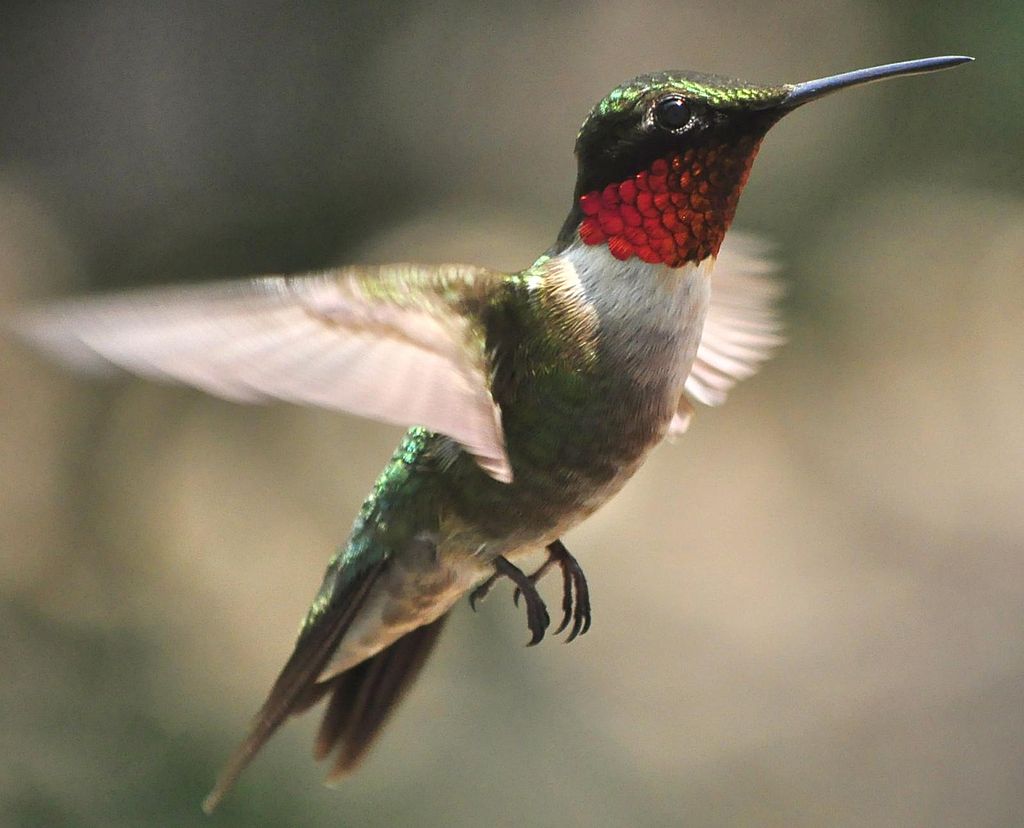
Ruby-throated Hummingbirds are the most common hummingbirds in Florida, and they stick around all year. They are named after the males’ ruby-red throats, and both males and females have emerald or golden-green backs. They resemble nothing so much as a feathery jewel. If some of these pass by, and there’s a good chance they will, they’re sure to catch your eye with their exotic, shimmering colors.
Ruby-throated Hummingbirds prefer to hang out in forests, and they build their nests in deciduous trees, like the birch, oak, and poplar. They can be enticed to visit your yard with flowers, like trumpet honeysuckle, red cardinal flowers, scarlet beebalm, wild bergamot, and trumpet creeper. They also love classic hummingbird feeders filled with nectar!
- Length: 3-3.5 in
- Weight: 0.11 oz
- Wingspan: 4.75 inches
Rufous Hummingbird (Selasphorus rufus)
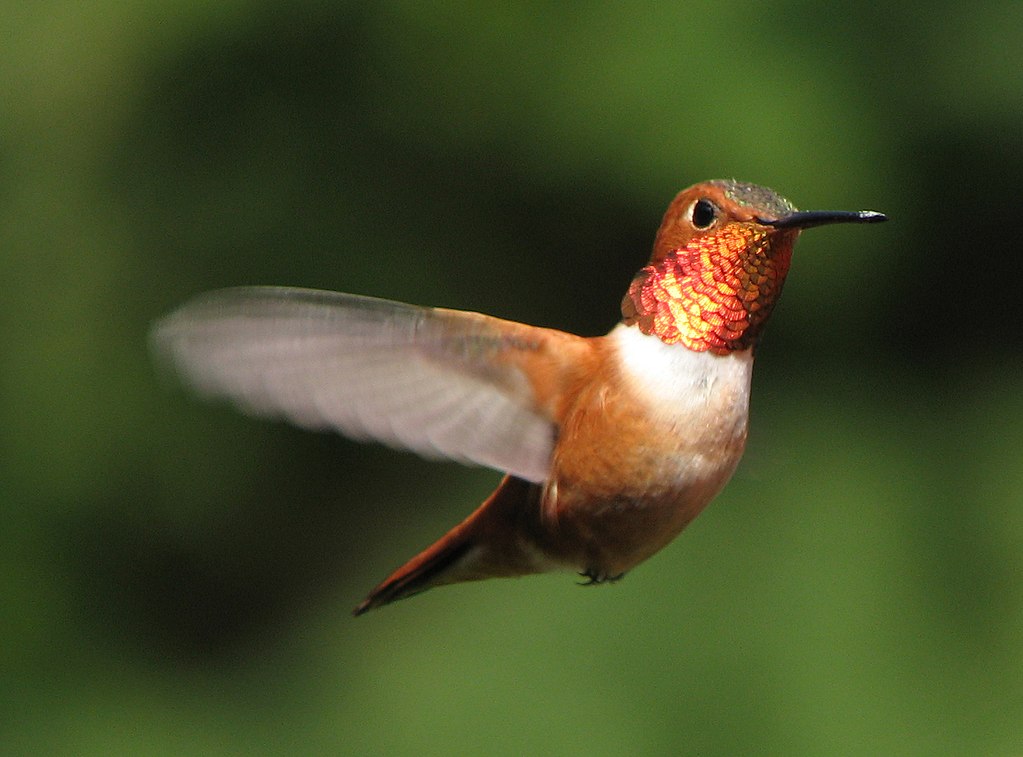
The Rufous Hummingbird is another beloved Florida native. These little guys can be seen in gardens and at feeders throughout the year.
Rufous Hummingbirds are remarkably bold for hummingbirds and have been observed chasing larger birds, rodents, and other hummingbirds away from their favorite garden spot or feeder. This means that they might stick around long enough for you to get a good look!
Both male and female Rufous Hummingbirds can be identified by their green backs, and their namesake, their rufous tail feathers with white tips. Male Rufous Hummingbirds also boast gorgeous, iridescent orange necks. This sometimes causes them to be confused with the Ruby-throated Hummingbird.
Rufous Hummingbirds tend to nest in open areas, like shrubby fields, parks, or the edges of forests. Some can even be found in swamps, a surprising flash of color!
In the wild, Rufous Hummingbirds drink nectar. They will also drink sap from holes left by other sapsucking animals when there is little nectar. Bugs like gnats and small spiders make up the remainder.
To make Rufous Hummingbirds at home in your yard, plant flowers like bearberry flowers, red cardinal flowers, Columbia lilies, and milkweed. Also, provide a hummingbird feeder filled with nectar.
- Length: 2.8-3.5 inches
- Weight: 0.12 oz
- Wingspan: 3-4 inches
Rare Hummingbirds in Florida (Non-Native)
These are hummingbirds that don’t live in Florida, but might pass through at certain times of the year. Some can even be spotted year-round, but compared to common hummingbirds, they’re significantly rarer. To see one of these hummingbirds, you’ll need to take the proper steps, as well as a bit of extra luck!
Calliope Hummingbird (Selasphorus calliope)
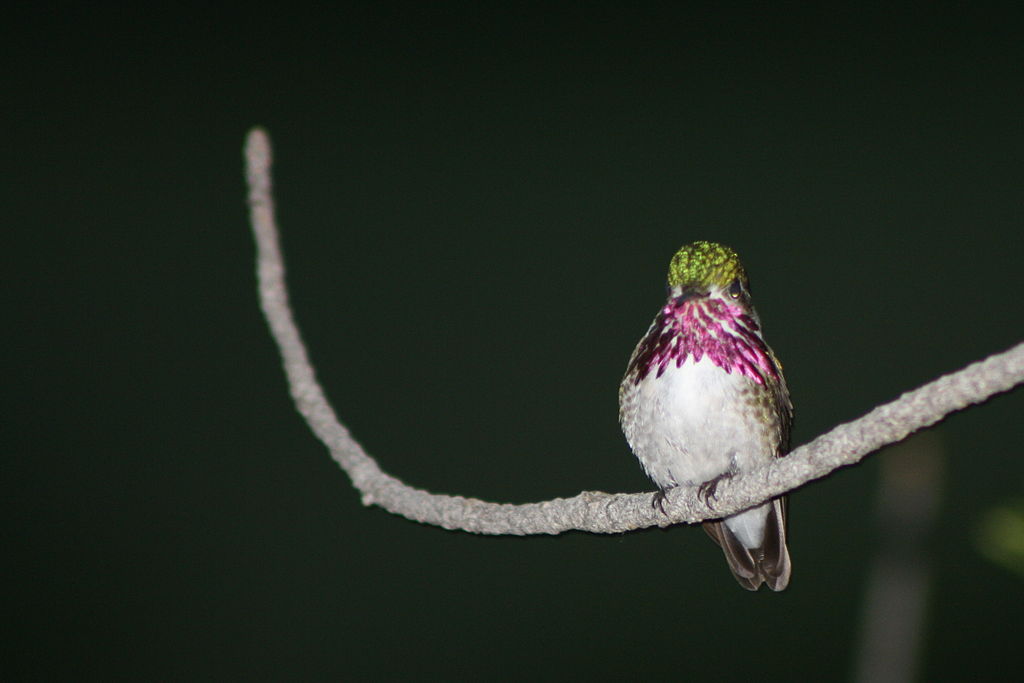
Calliope Hummingbirds are fairly rare in Florida, and much more common in California, Mexico, and Canada. This being said, like magic, they will sometimes still appear.
The most remarkable about Calliope Hummingbirds is just how tiny they are; at only 2.8-3.9 inches and 0.071- 0.106 oz, they are the smallest breeding birds in North America (maybe ever).
Male Calliope Hummingbirds are sometimes misidentified as Ruby-throated Hummingbirds, due to somewhat similar, wine-red markings on their throats. The females lack this coloration, and both birds have green backs, white bellies, and striking, dark, white-tipped tails.
These hummingbirds are most at home in open spaces and spend their time in meadows and canyons (especially in the mountains).
Although they consume some small bugs, like aphids, for protein and fat, Calliope Hummingbirds feed primarily on flower nectar. You can draw them to your yard with bright, nectar-rich blossoms like red bee balm, red honeysuckle, foxgloves, and hollyhock!
- Length: 2.8-3.9 inches
- Weight: 0.071- 0.106 oz
- Wingspan: 4.3 inches
Buff-bellied Hummingbird (Amazilia yucatanensis)

Buff-bellied Hummingbirds are named for their buffy-colored bellies (a pastel pink-yellow shade). They are not often seen in Florida, as they are not natives, but they are known to wander through. They are most recognizable for their exceptionally long red beaks and buffy bellies. Their backs are light green, and their feathers are beautifully iridescent.
Native to Mexico, Buff-bellied Hummingbirds like to hang out along the coast, in thickets and forests. They build their nests in deciduous trees, like sycamore, birch, and oak. These avid flower-lovers consume primarily nectar.
To lure Buff-bellied Hummingbirds to your yard, all that you need are some flowers in your garden, like Turk’s cap, red salvia, and red honeysuckle, along with a hummingbird feeder filled with nectar!
- Length: 3.9-4.3 inches
- Weight: 0.14-0.18 oz
- Wingspan: 5.75 inches
Broad-tailed Hummingbird (Selasphorus platycercus)
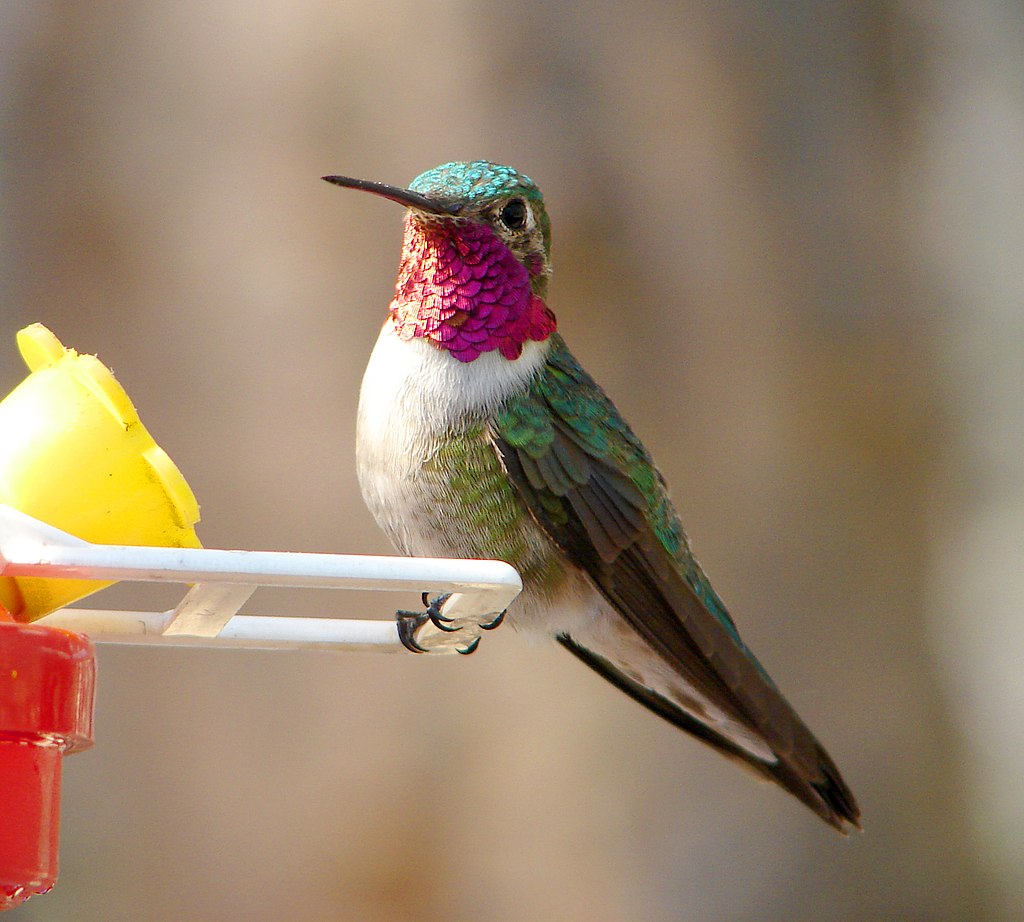
The broad-tailed is an elusive bird, found mainly in South-East Florida. You’re highly unlikely to see it elsewhere in the state, making it a hummingbird that’s rarer. Broad-tailed Hummingbirds are medium-sized hummingbirds, and they live up to their name with their wide, impressive tails. The males and females have mostly green backs and white belly feathers, and the male features a lovely iridescent orange throat (not to be mistaken with the Ruby-throated Hummingbird).
In the wild, they reside in high elevation areas, such as scrubby meadows, or among evergreen forests. They consume a fairly even distribution of bugs and nectar.
You can draw them to your yard by planting their favorite flowers, paintbrush, along with honeysuckle, beebalm, and other flowers that are brightly hued (preferably red) and tubular. You can also put out a hummingbird feeder full of nectar.
- Length: 3.3-3.8 inches
- Weight: 0.13 oz
- Wingspan: 5.25 inches
Allen’s Hummingbird (Selasphorus sasin)
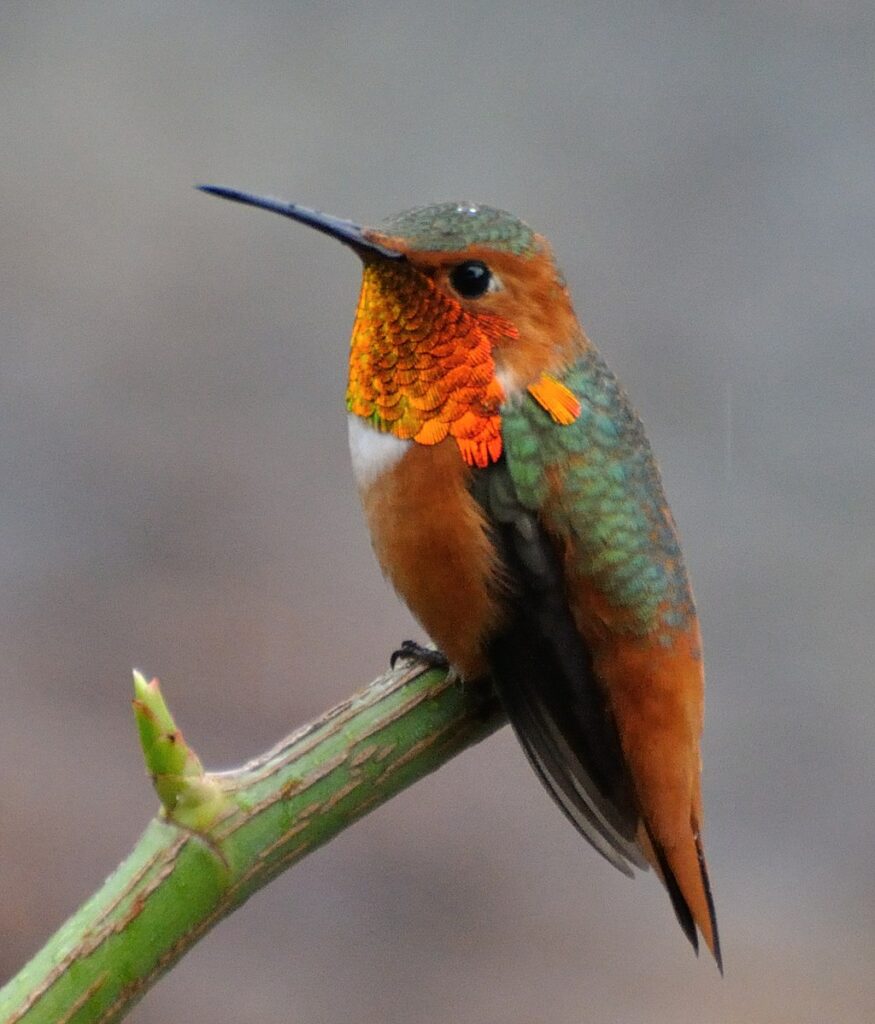
The Allen’s Hummingbird is a super-round little fellow. They show up in Florida only once in a blue moon, and to see one, you’ll need some luck! The males have lovely, iridescent, burnt-orange throats, coppery backs, and orange-tan bellies. Females lack the orange neck and are more muted in color.
These adorable hummingbirds nest in forests and scrubby meadows along the coast of Oregon and California. They will sometimes migrate to Mexico (and rarely happen through Florida), in the winter!
Allen’s Hummingbirds drink nectar and tree sap and supplement their diet with bugs, which provide vital protein and fat. You can entice them to visit your yard by painting flowers, particularly red salvia, paintbrush, honeysuckle, and hollyhock! They will also gladly take advantage of a hummingbird feeder filled with nectar.
- Length: 3-3.5 inches
- Weight: 0.1 oz
- Wingspan: 4.3 inches
Black-chinned Hummingbird (Archilochus alexandri)

The Black-chinned Hummingbird is a truly striking fellow! The males boast velvety-black heads that blend into dark purple necks. The females have white necks. Both have white bellies, and their bills are black. Their sides are a dusky-green color.
In Florida, Black-chinned Hummingbirds will occasionally make an appearance in the winter. They prefer to hang out in woodlands, meadows, and orchards. They will also happily come if you plant flowers like scarlet larkspur and red honeysuckle in your garden, and put out a hummingbird feeder filled with nectar!
- Length: 3.25 inches
- Weight: 0.11 oz
- Wingspan: 4.3 inches
Bahama Woodstar Hummingbird (Calliphlox evelynae)

While Bahama Woodstars are native to the Bahamas, some stray to Southern Florida in lowlands and tropical forests. If you’re fortunate enough to see one, you’re sure to be astounded by their color.
These tiny birds have golden-green backs, and the male displays a gorgeous violet neck. The males have white bellies, while the females’ bellies are cinnamon in color. In the wild, they feed primarily on nectar.
The most common sightings of Bahama Woodstar Hummingbirds in Florida occur at the hummingbird feeder. If you’re hoping to see one, this may do the trick!
- Length: 3.1-3.7 inches
- Weight: 1.06 oz
- Wingspan: 4.25 inches
Anna’s Hummingbird (Calypte anna)

While Anna’s Hummingbirds stick mostly to the western coast of the US, they can also be spotted in Florida, rarely, any time of the year. These breathtaking birds are mostly green-gray, but the males feature a magenta or red-orange crown and throat. The females lack this bright crown and throat, and are more subtle, yet still lovely, in color. They love open woods, especially forests of oak. Most will remain in one area, as they are very territorial.
To encourage Anna’s Hummingbirds to stop by, you can plant red flowers gooseberry, hummingbird sage, eucalyptus, and desert willow in your garden, as well as keep a hummingbird feeder filled with nectar.
- Length: 3.9 inches
- Weight: 14-0.16 oz
- Wingspan: 4.7 inches
Broad-billed Hummingbird (Cynanthus latirostris)

Broad-billed Hummingbirds are quite colorful, with wide, bright-red beaks, and green and blue feathers all over.
When it comes to food, Broad-billed Hummingbirds prefer nectar. They will also eat any bugs that they find on plants, however.
These birds are native to the canyons and meadows of Mexico, and they are seen in Florida only rarely. If you want to increase the chances of one stopping by, you can plant paintbrush, honeysuckle, Ocotillo, and hollyhock. They will also appreciate a nectar-filled hummingbird feeder!
- Length: 3 and ¼-4 inches
- Weight: 1 oz-0.125 oz
- Wingspan: 5 inches
Blue-throated Mountain Gem (Lampornis clemenciae)

Blue-throated Mountain Gems are mostly dusky-green in color. Their most distinguishing characteristic is the male’s blue throat. Both males and females have a streak of white above and below the eye, and gray bellies. The birds vary in whether they are darker or lighter in color. They are rather large for hummingbirds, at 4.3-5.5 inches and 0.27 oz. This can make them a bit entitled at the feeder. They may scare ‘rival’ hummingbirds off.
Blue-throated Mountain Gems are native to the coniferous forests of Texas and Mexico and feed primarily on flowers that grow abundantly along streams. They will sometimes stray to Florida, particularly in the winter. To increase your chances of seeing one, plant some daylilies, honeysuckle, red cardinal flowers, etc., and hang a hummingbird feeder filled with sugar water!
- Length: 4.3-5.5 inches
- Weight: 0.27 oz
- Wingspan: 5 inches
Mexican Violetear (Colibri thalassinus)

The Mexican Violetear resides in the alps of Mexico, though it can also make rare excursions to Florida throughout the year. They gravitate toward forest clearings and edges.
These medium-sized hummingbirds are quite striking, colored emerald-green with a violet patch over their ear. The males and females both feature this unique marking, though the females’ ear patches are narrower. In the wild, Mexican Violetears eat a mix of bugs and nectar.
You can entice them to visit your home by planting honeysuckle, red salvia, red cardinal flowers, and others that are bright red in color. They will also happily enjoy a hummingbird feeder full of nectar!
- Length: 3.8-4.7 inches
- Weight: 0.21 oz
- Wingspan: 7 inches
Costa’s Hummingbird (Calypte costae)
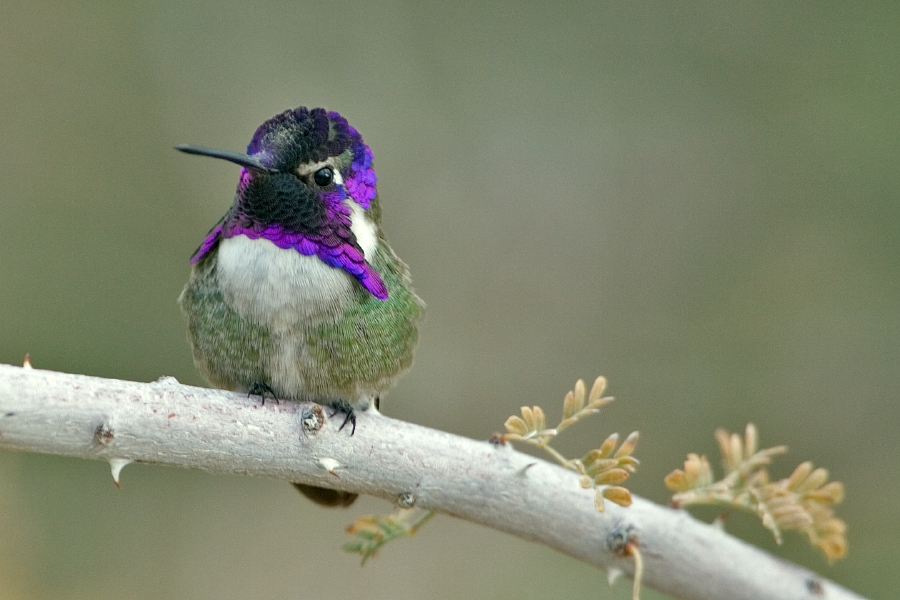
The Costa’s Hummingbird is best known for its iridescent purple crown and gorget. It also has a green vest and green back. The females lack the purple crown and gorget, and, as is typical for female birds, are more muted in color. Both males and females have white eyebrow stripes and white bellies.
These hardy birds are accustomed to the desert scrub of southern California. They do very rarely pass through Florida, however! They can be drawn to your yard with some of their favorite flowers, such as desert honeysuckle, larkspur, and desert lavender. They will also be grateful for a feeder!
- Length: 3.5 inches
- Weight: 0.11 oz
- Wingspan: 4.3
Final Thoughts
Did you know there were so many hummingbirds that visited Florida? The native ruby-throated hummingbird and Rufous Hummingbird are almost guaranteed to show up at a hummingbird feeder. With others, you’ll also need a bit of luck!
While some of these birds can show up year-round, many will visit in the winter. Just plant a profusion of humming-bird-friendly flowers, like honeysuckle, paintbrush, red cardinal, and larkspur, and keep a well-stocked hummingbird feeder!
